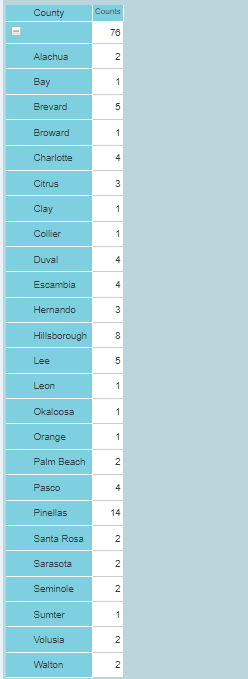Florida: Vibrio vulnificus cases in 2024, post Hurricane Helene and Milton, top totals post Hurricane Ian in 2022
The number of Vibrio vulnificus cases reported in 2024 through Oct 17 has topped the numbers recorded in all of 2022, the year Hurricane Ian stuck southwest Florida.
According to Florida Department of Health (FLDOH) data, 76 V. vulnificus cases and 13 deaths have been recorded through Oct. 17. In all of 2022, the previous high and the year of Hurricane Ian, 74 cases and 17 deaths were recorded.
Certain counties on the west coast of Florida have been hit extraordinarily hard in recent weeks, including Hillsborough and Pinellas counties (see above).
In 2023, 46 cases and 11 deaths were reported.
According to FLDOH, Vibrios are gram-negative bacteria that are found in estuarine and marine environments. They colonize filter feeding animals such as shellfish and can also be found free-living in seawater.
Given their distribution, most Vibrio vulnificus (V. vulnificus) infections occur in states surrounding the Gulf of Mexico.
People become infected with the bacteria in several ways. One way is by consumption of raw or undercooked seafood or cross-contamination of food with contaminated water. In healthy individuals, the bacteria can cause symptoms of gastroenteritis that generally lasts about three days. However, in those who are immunocompromised the bacteria can infect the blood causing septicemia that can cause severe or deadly infections in other parts of the body. Septicemia can be characterized by fever and chills, occasionally accompanied by vomiting, diarrhea, abdominal pain, and pain in the extremities. Death occurs in an average of 35% of septicemia cases. Those at highest risk for developing septicemia are those who are immunocompromised or have other chronic health problems, such as high serum iron levels or liver disease.
Another way that people can be infected with the bacteria is through an open wound exposure to seawater. Wound infections can be characterized by inflammation at the wound site, which can progress to cellulitis, bullous lesions, and necrosis. Infections can become systemic which can lead to additional symptoms of chills, fever, hypotension, and altered mental status. The health status of individuals can determine the severity of illness, as death or amputations can be a result of wound infections. People with underlying medical conditions may be at increased risk of infection and serious complications.
Infections from Vibrio bacteria that cause cholera and vibriosis have been reportable diseases in Florida since 1981. In 2007, infections caused by Vibrio vulnificus and other vibrio species became nationally notifiable.
From 2000 to 2022, there has been an average of 34 V. vulnificus cases reported each year in Florida.
Between 2004 and 2023, there were 697 confirmed and probable cases of V. vulnificus. During that time frame, there were 188 deaths reported associated with V. vulnificus infection. For V. vulnificus cases, wound infections accounted for 54% of cases, seafood exposures accounted for 20% of reported cases and the remaining 26% had exposures that could not be classified due to multiple factors (unable to interview, had both exposures to seawater and raw seafood).






